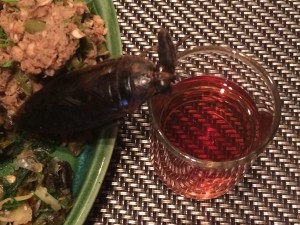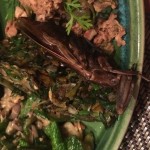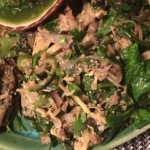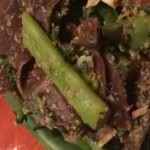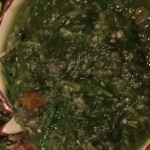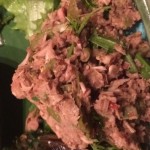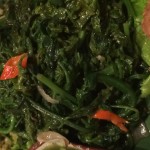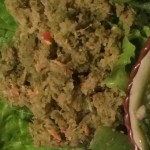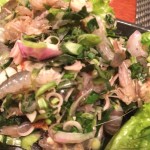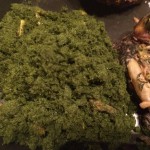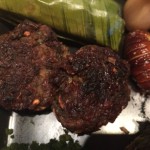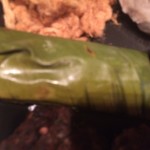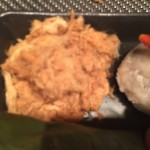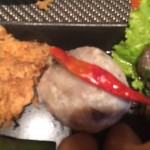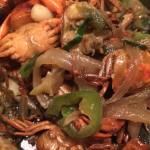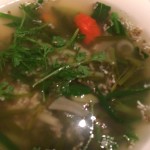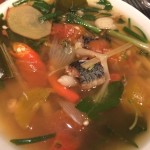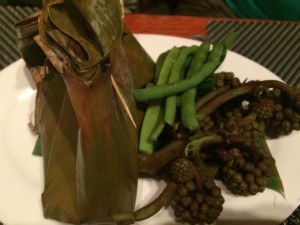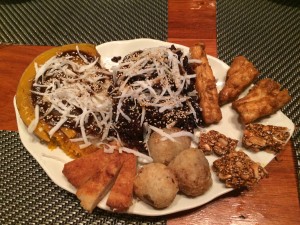Simply put, Laotian food is amazing. There is a lot of national pride around the nation’s culinary heritage, and a combination of gratification and resentment that Thai cuisine has apparently “borrowed” a number of the area’s most renowned dishes. (Both the Lao and the Thai people are descended from a broader diaspora of Tai peoples whose reach extends from India to China, as well as Southeast Asia. So perhaps we can call a truce and deem it a shared heritage. . .)
Now, there are two ways to experience Lao cuisine. The first is the safe route, sticking to well-known staples such as:
- Sticky rice (which comes in white, brown or purple varieties)
- Laap, a spicy, minty salad of marinated minced buffalo, chicken, pork or fish (sometimes served raw so the more cautious explorer will do well to ask in advance)
- Tangy papaya salad
- Any combination of amazing dips, or jaew, which range from the almost salsa-like jaew mak len and eggplant-based jaew mak khua to the more adventurous but equally delicious jaew bong, a chili paste whose special ingredient is, of all things, buffalo skin. These dips are served with rice crackers and dried river weed (which may sound unappetizing at first but is little different from seaweed at the end of the day)
- Local meatballs and sausage;
- Various stir fried greens – some of which you would have never imagined eating — but are delicious nonetheless.
The second is what I like to call the “Anthony Bourdain on crack” approach. (You can view the episode on his visit to the Land of a Million Elephants below — though apparently not in all markets. Vientiane — check. Jakarta — check. Auckland — fail.)
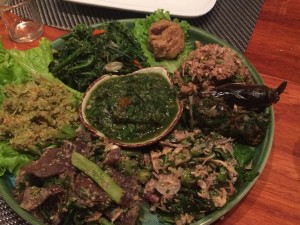 This is the approach advocated by my friend Jason, who is not only a craft beer and whiskey/whisky aficionado (I never asked him if he’s an Irish or Scotch man), but also one of the most adventurous eaters I have ever met. So it is with great glee that he comes across Tamarind‘s Adventurous Lao Gourmet degustation menu. (As readers of this blog are likely aware, degustation means tasting in French. Finicky eaters will undoubtedly think of this more as a “disgusting” menu, and should opt for some of Tamarind’s tamer dishes.) For someone like me, who definitely draws a firm line between food and insects, it is still worth a try (barely!) For someone like Jason and his good sport better half Erin, it is a must do. (Rubbing his belly after the feast, Jason proclaimed that he could “go home” now because he’d reached the apex of his trip.)
This is the approach advocated by my friend Jason, who is not only a craft beer and whiskey/whisky aficionado (I never asked him if he’s an Irish or Scotch man), but also one of the most adventurous eaters I have ever met. So it is with great glee that he comes across Tamarind‘s Adventurous Lao Gourmet degustation menu. (As readers of this blog are likely aware, degustation means tasting in French. Finicky eaters will undoubtedly think of this more as a “disgusting” menu, and should opt for some of Tamarind’s tamer dishes.) For someone like me, who definitely draws a firm line between food and insects, it is still worth a try (barely!) For someone like Jason and his good sport better half Erin, it is a must do. (Rubbing his belly after the feast, Jason proclaimed that he could “go home” now because he’d reached the apex of his trip.)
For around US$ 25 apiece, we got to sample over 20 different dishes — beginning with banana-flavored lao lao, a traditional spirit distilled from rice, and ending with a dessert platter and coffee or tea. Value for money doesn’t even begin to describe the experience.
Round 1: Aperitifs
We whet our appetites with shots of banana lao lao (which the Lao call whisky, and we call moonshine). We are also offered refreshing ginger and lemongrass drinks, and I spice things up (literally!) with an absolutely amazing watermelon chili granita. Then the adventure really begins.
Round 2: Vegetable Platter (which comes with extra protein)
- I think this is pretty self explanatory
- Banana Flower with Bamboo Shoots
- Steamed Vegetables
- Pureed River Weed
- Baby Jackfruit
- Boiled Rice Cracker
- Stir Fried Fern
- Sour Plum
The first food round really tests our mettle — nestled among 8 dishes is stir fried water bug. I would have been up for the challenge (the chopped up bug bits look like mushrooms). But — Tamarind “helpfully” wants to remind you of what you are eating — and a giant water bug proudly sits on top of the platter. I’m not particularly squeamish about bugs, but roaches are my Kryptonite. And, unfortunately, the water bug looks like the world’s biggest cockroach. (Water bugs are actually a kind of scorpion, but the eyes see what the eyes want to see!) Like a malevolent Mona Lisa, its baleful eyes seem to follow my every move, and I begin to feel slightly queasy. (To be fair, this could very possibly be attributed to the street-side BBQ chicken that I’d enjoyed earlier in the day — but I prefer to blame the bug.)
I admit it, I COMPLETELY wimp out. I happily eat AROUND the bug dish, while Jason and his wife Erin bravely dig in. Unexpectedly, it’s the chili — not the bugs — that almost does them in. (Jason’s theory is that Tamarind’s chef amps up the spice levels so people don’t feel guilty about not finishing their portion. Erin figures if your mouth is numb you can’t taste the bug.) Either way, despite their most valiant efforts, neither of them can manage more than a couple of bites.
On the platter we also enjoy banana flower with bamboo shoots, sauteed ferns (which tastes much better than in sounds!) a medley of steamed vegetables including mushrooms, mustard greens, and a Southeast Asian specialty called “pea eggplant” which resembles overgrown capers. We also sample a sour plum-based puree, as well as rice crackers boiled with ginger and sugar. In true Lao fashion, we make miniature sticky rice balls with our fingers and dip these into the platter, using our thumbs to scoop up bite-sized portions of food.
Round 3: Protein Platter
- Baby Shrimp
- Beetle Larvae
- Riverweed Powder
- Buffalo Meatballs
- Pork and Pigskin in Banana Leaf
- Sweet Pork Floss
- Fermented Fish
- Little Crabs
So, the secret protein on this platter was beetle larvae. With memories of my roach nemesis still fresh in my mind, I steer clear of these. Due to a shellfish allergy I avoid the fragrant baby shrimp cooked in lemongrass and chili and the miniature crabs (which Erin finds more difficult to eat than the beetles, and even crunchier.) I like the buffalo meatballs, am ambivalent about the riverweed powder (it resembles matcha toasted with ginger and garlic, and I can’t help but think it would wonderful with Japanese pickled plum). I think about my Chinese mother as I sample sweet pork floss, and avoid the fermented fish (which is basically Lao gefilte-fish) and the sour pork and pigskin wrapped in a banana leaf. Food coma is clearly beginning to set in, because at this stage at the meal I scribble even more illegibly that usual (the last dish on the platter appears to have been some sort of fish and shrimp in a banana leaf. . .)
Round 4: Soups
- Ant Egg Soup (spot the ant eggs, anyone?)
- Snake Soup
We are presented with two soups — snake soup (yup, it really does taste like chicken — chicken with tiny, tiny bones) Lao people traditional eat the snake skin — we find that we are not Lao in this regard. And ant egg soup. Ant egg omelets — Jason’s primary quest grace a Mr. Bourdain — are seasonal – and he is disappointed to learn that the eggs are too small at this time of year. But we all enjoy the soup — the eggs look like rice granules (I see an excellent prank coming up!) But again — fiery hot spice levels.
Round 5: Fish
This tiny catfish (we never knew that they came this small!) delicately seasoned with lemongrass, fish sauce and chili is absolutely scrumptious. However, we are so full that we can only enjoy a couple of bites. The next day we would see massive bins of these fish at the morning market, squirming around like eels.
Round 6: Flowers
This dish is basically mushy and extremely bitter, and is not a particular hit with any of us. However, the presentation was interesting, and we remind ourselves that even though we are not fans, bitterness is a highly prized flavor in Lao cooking. (Along with salty and sour, bitterness forms a taste profile trifecta in the cuisine.) We are far more interested in the so-called “earring fruit” that accompanies the dish. (Lao food-naming conventions are VERY creative, as you will continue to see. . .)
Round 7: Dessert
We have no idea how we are going to eat dessert, but what they say must be true — dessert goes into another part of the stomach. So we shift on our seats and make some room to feast on purple sticky rice boiled coconut milk and flavored with coconut tamarind sauce (which is so delicious that I buy a jar to take home with me.) We also tuck into pumpkin custard steamed in the rind, In an effort to be Lao, we attempt to gnaw on the tough exterior which elicits a chuckle from the restaurant manager — Lao eat ALMOST everything, but not that. Finally, rice powder and coconut skewers, a delicious cookie made from rice powder and palm sugar known rather appetizingly as “cat poo”, and a brittle-like cracker of sesame and peanuts. I am not usually a fan of coconut, but everything is so delicious.
After our three-plus hour dinner, as we cross the rickety bamboo foot bridge which spans the Nan Khan River to return home, we consider the distinct possibility of crashing through the slats in an Indiana Jones-like manner given how full we feel. It’s almost impossible to imagine that when we wake up 9 hours later, we will be back at Tamarind learning how to cook ourselves! (No, there were no bugs on that menu.) More to come on Lao food!
Are readers interested in recipes along with the posts? Let me know!







